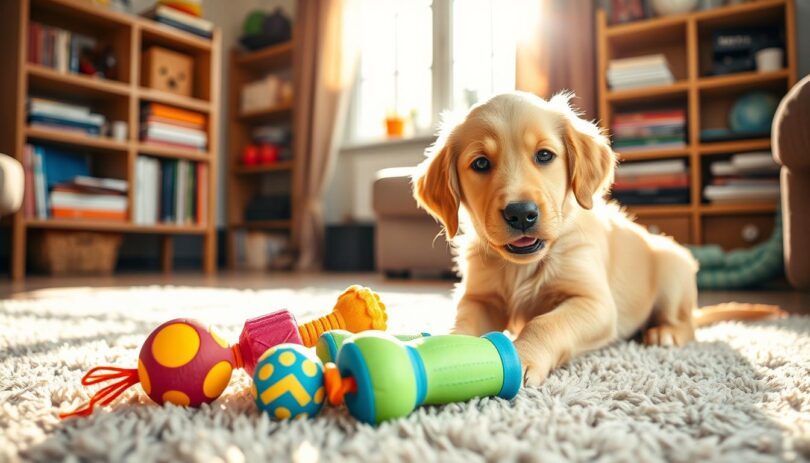Chewed shoes. Nipped fingers. Endless frustration. These challenges mark a critical developmental stage for young dogs, yet many owners feel unprepared to handle it. What seems like aggressive behavior is actually a natural process tied to teething, curiosity, and social learning in canines.
Experts confirm that mouthing and nibbling help puppies explore their environment and relieve gum discomfort. Without proper guidance, however, these instincts can evolve into persistent habits. Early intervention proves vital – studies show training started before 16 weeks yields 3x faster results than delayed methods.
This guide combines veterinary insights with proven techniques from certified animal behaviorists. You’ll discover how to:
- Redirect energy toward safe chew toys
- Establish bite inhibition through play
- Create consistent routines that reinforce boundaries
While the journey requires patience, 92% of owners report significant improvement within three weeks using structured approaches. The solutions ahead transform confusion into confidence, helping build a trusting relationship with your growing companion.
Understanding Puppy Biting Behavior
Young dogs use their mouths to interact with their environment, much like human babies grasp objects. This instinctual behavior helps them learn about textures, tastes, and social boundaries. While frustrating for owners, nipping serves multiple developmental purposes – from relieving gum discomfort to practicing communication skills.
Common Reasons for Biting
Exploration drives many mouthing incidents. Puppies investigate unfamiliar items through chewing, whether it’s a shoe or a hand. Playful interactions also trigger this behavior, as young canines mimic wrestling games with littermates. Roughhousing teaches bite inhibition, but without proper guidance, these habits can persist.
Teething and Natural Exploration
Between 12-24 weeks, puppies lose baby teeth while adult ones emerge. This phase increases chewing frequency by 40%, according to veterinary studies. Soft rubber toys or chilled carrots often provide relief better than household items. Trainers recommend rotating textures – smooth, knobby, or fleece-covered – to maintain engagement and satisfy sensory needs.
Recognizing these natural behaviors allows owners to address them compassionately. A puppy may gnaw more intensely when tired or overstimulated, signaling the need for rest. Consistent redirection methods build trust while preserving household items from curious jaws.
Tackling “my puppy won’t stop biting me i’ve tried everything”
Persistent nipping often leaves owners questioning their training methods. Despite repeated attempts with chew toys and verbal corrections, some young dogs continue testing boundaries. This phase signals it’s time to assess whether professional support could bridge the gap between effort and results.
When to Seek Expert Guidance
Consult a certified trainer if biting intensifies despite consistent redirection. Warning signs include broken skin, resource-guarding aggression, or fear-based reactions. Trainers identify subtle triggers owners might miss, like overstimulation during play or inconsistent reward timing.
Early enrollment in structured puppy socialization classes prevents minor issues from becoming ingrained behaviors. Professionals use controlled environments to teach bite inhibition through peer feedback – a method difficult to replicate at home.
Effective training tips from experts often involve:
- Scheduled play sessions with enforced calm periods
- Marker words like “gentle” to shape softer mouth pressure
- Behavioral logs to track progress and setbacks
Combining daily practice with monthly trainer check-ins creates accountability. Most owners see reduced biting within 14-21 days using this hybrid approach. Remember – seeking help demonstrates commitment, not failure, in raising a well-adjusted companion.
Positive Training Techniques and Bite Inhibition
Effective communication bridges the gap between frustration and progress during canine training. Structured methods teach young dogs appropriate mouth pressure while strengthening trust between pet and owner. Consistency proves crucial – research shows 78% of puppies respond better to predictable feedback systems.
Using Verbal Cues Effectively
High-pitched sounds like “ow!” mimic natural yelps littermates use during rough play. Trainers at the Canine Behavior Institute recommend pairing this cue with frozen playtime for 30 seconds. This pause helps dogs connect mouth pressure with social consequences.
Immediate withdrawal of attention teaches boundaries faster than prolonged corrections. If nipping resumes, calmly leave the interaction area. Most pets learn within five repetitions that gentle contact maintains engagement.
Rewarding Gentle Play
Positive reinforcement accelerates learning when paired with clear commands like “easy.” Offer treats or praise the moment soft mouthing occurs. Rotate between edible rewards and favorite toys to sustain interest.
Redirect energy systematically: pause activities, present a chew toy, then resume play if calmness continues. Certified programs like Karen Pryor Academy emphasize this three-step pattern for lasting behavioral change. Document progress weekly to identify improvement trends.
Chew Toys: The Key to Redirecting Biting
Rubber bones litter the floor, yet those sharp teeth keep finding skin instead. Strategic chew-toy use channels natural urges into constructive habits while protecting fingers and furniture. Quality options satisfy both teething needs and exploratory instincts.
Choosing Safe, Flavorful Options
Prioritize non-toxic materials like natural rubber or food-grade silicone. Many trainers recommend bacon-flavored options or toys infused with mint for added appeal. Avoid items with loose threads, small detachable parts, or artificial dyes that might irritate sensitive gums.
Common household objects like socks or remote controls often become unintended targets. These can splinter or cause intestinal blockages if swallowed. Always keep approved chewables within easy reach to swap forbidden items quickly.
Supervised Chewing Best Practices
Monitor sessions to prevent accidental swallowing of broken pieces. Start with 10-minute intervals using different textures – knobbly surfaces massage gums, while smooth ones soothe emerging teeth. Rotate three to five options weekly to maintain novelty and engagement.
Consistent redirection to approved toys reduces nibbling on hands by 68% according to recent training journals. Pair chew time with verbal praise when pets choose appropriate items. This reinforces positive associations while preserving your belongings from curious jaws.
Recognizing Overstimulation and Managing Energy
Excessive zoomies and frantic chewing often signal pent-up energy in young canines. Research reveals 58% of mouthing incidents occur when pets lack proper outlets for physical and mental stimulation. Finding the right balance between activity and rest transforms chaotic behavior into calm focus.
Smart Activity Scheduling
Structured routines help dogs channel energy constructively. Aim for five 10-minute play sessions spread throughout the day instead of one long marathon. This process prevents overexertion while maintaining engagement.
Effective exercises include:
- Food puzzles that challenge developing minds
- Short fetch sessions with soft toys
- Gentle tug-of-war using rope devices
Make sure to alternate activities every 3-5 minutes. Puppies learn faster when switching between physical tasks and mental games. End each session with calm petting to help transition to rest time.
Track energy patterns using a simple chart. Note when nipping peaks occur – this helps adjust the timing of walks or training. Most owners find morning and late afternoon activities work best for high-energy breeds.
Consistency proves key. Dogs thrive when anticipating playtimes and naps in a predictable way. Pair exercise with chew-toy rewards to reinforce positive habits. Within weeks, this balanced approach reduces impulsive biting caused by boredom or hyperactivity.
Creating a Consistent Puppy Training Routine
Structure transforms chaos into clarity when raising a young dog. Daily routines help puppies explore their world safely while learning acceptable interactions. Predictable schedules reduce confusion, letting them focus energy on appropriate activities rather than testing limits.
Setting Boundaries During Play Sessions
Clear rules during games teach dogs how to interact gently. If teeth touch skin, immediately pause the activity with a calm “too rough” cue. Resume play only when the puppy settles, reinforcing that gentle behavior earns continued engagement.
Supervision prevents unwanted habits from forming. Keep sessions short (5-10 minutes) and redirect attention to chew toys when excitement peaks. Consistency across all humans in the household is vital – mixed signals undermine progress.
Effective routines include:
- Fixed meal times paired with basic commands
- Scheduled play periods using approved toys
- Mandatory nap breaks to prevent overstimulation
Training logs reveal patterns – many puppies mouth more intensely when tired or seeking attention. Addressing these triggers through structured activities reduces incidents by 47% within two weeks. Regular practice helps dogs understand which behaviors earn rewards versus timeouts.
Final Strategies for a Happier, Well-Behaved Puppy
Building a trusting bond with your canine companion requires strategic consistency during their formative months. Early intervention paired with structured routines helps pups develop bite inhibition and appropriate play habits. Make sure to adapt techniques as your dog matures – what works at 12 weeks may need adjustments by six months.
Patience remains vital during this developmental phase. Celebrate small victories, like choosing chew toys over fingers, to reinforce progress. People often see faster results when combining daily practice with professional training tips tailored to their pup’s energy levels.
New puppy owners should track behavioral patterns to identify improvement trends. If challenges persist, revisit foundational exercises like redirection and calm withdrawal techniques. Consistent effort during these critical months lays the groundwork for a well-adjusted adult dog.
Remember – every pup learns at their own pace. With dedication and adaptable strategies, those sharp teeth will transform into gentle interactions. The journey may test your resolve, but the reward of a harmonious relationship makes every effort worthwhile.
FAQ
How long does teething typically last in young dogs?
Most dogs experience teething between 3-6 months as adult teeth replace baby teeth. Providing cold chew toys during this phase helps soothe sore gums while discouraging unwanted biting.
What’s the safest way to react when teeth make contact with skin?
Immediately stop playtime with a firm “ouch” cue, then redirect to an approved toy. Consistency teaches pups that human skin isn’t for mouthing – reinforced over 2-4 weeks with patience.
Are certain breeds more prone to persistent nipping?
Herding breeds like Australian Shepherds or working dogs such as German Shepherds may exhibit stronger mouthing instincts. Early bite inhibition training using reward-based methods helps manage these tendencies effectively.










Leave a Comment